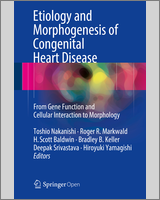Open Access This chapter is distributed under the terms of the Creative Commons Attribution-Noncommercial 2.5 License (http://creativecommons.org/licenses/by-nc/2.5/), which permits any noncommercial use, distribution, and reproduction in any medium, provided the original author(s) and source are credited. The images or other third party material in this chapter are included in the work's Creative Commons license, unless indicated otherwise in the credit line; if such material is not included in the work's Creative Commons license and the respective action is not permitted by statutory regulation, users will need to obtain permission from the license holder to duplicate, adapt or reproduce the material.
NCBI Bookshelf. A service of the National Library of Medicine, National Institutes of Health.
Nakanishi T, Markwald RR, Baldwin HS, et al., editors. Etiology and Morphogenesis of Congenital Heart Disease: From Gene Function and Cellular Interaction to Morphology [Internet]. Tokyo: Springer; 2016. doi: 10.1007/978-4-431-54628-3_15

Etiology and Morphogenesis of Congenital Heart Disease: From Gene Function and Cellular Interaction to Morphology [Internet].
Show detailsOver the last decade, stem/progenitor cell therapy has emerged as an innovative approach to promote cardiac repair and regeneration. However, the therapeutic prospects of are currently limited by inadequate means to regulate cell proliferation, homing, engraftment, and differentiation. Autophagy, a lysosome-mediated degradation pathway for recycling organelles and protein aggregates, is recognized as important for facilitating cell differentiation. Studies have shown that induced pluripotent stem cells (iPCs), which exhibit a predominantly glycolytic metabolism, shift toward oxidative mitochondrial metabolism as a prerequisite for the formation of sarcomeres and differentiation into cardiomyocytes. C2C12 myoblasts are a mouse-derived myogenic progenitor cell line which can be induced to differentiate into myotubes. We hypothesize that autophagy is essential in coordinating transcription factor activity and metabolic reprogramming of mitochondria to support myocyte differentiation.
Keywords:
Autophagy, Stem cell, DifferentiationC2C12 myoblasts were cultured in DMEM (10 % FBS) and induced to differentiate into myotubes with DMEM (2 % horse serum) for 6 days. To disrupt autophagy, cells were (1) transfected with 50 nM Atg5 siRNA for 8 h twice over a 48 h period or (2) treated with 10 nM bafilomycin A1 or vehicle control for a 3 h/day for the first 3 days of differentiation. GFP-LC3 adenovirus was employed to visualize autophagy. Western blot and real-time qPCR were used to examine proteins and transcripts of interest. We observed increased LC3-II levels and GFP-LC3 puncta during the differentiation of C2C12 cells, suggesting the involvement of autophagy in this process. Transient inhibition of autophagy during the early stages of differentiation with either Atg5 siRNA or bafilomycin A1 interfered with myotube formation and attenuated the upregulation of myogenic transcription factors MyoD and myogenin. Differentiation was accompanied by an increase in PGC1α mRNA, mitochondrial mass, and oxygen consumption, all of which were blocked by disruption of autophagy. Autophagy coordinates transcription factor expression and mitochondrial turnover essential for cell differentiation (Fig. 15.1).
- Mitophagy is required for mitochondrial biogenesis and myogenic differentiation of C2C12 myoblasts.[Autophagy. 2016]Mitophagy is required for mitochondrial biogenesis and myogenic differentiation of C2C12 myoblasts.Sin J, Andres AM, Taylor DJ, Weston T, Hiraumi Y, Stotland A, Kim BJ, Huang C, Doran KS, Gottlieb RA. Autophagy. 2016; 12(2):369-80.
- Coordinated Metabolic Changes and Modulation of Autophagy during Myogenesis.[Front Physiol. 2016]Coordinated Metabolic Changes and Modulation of Autophagy during Myogenesis.Fortini P, Iorio E, Dogliotti E, Isidoro C. Front Physiol. 2016; 7:237. Epub 2016 Jun 16.
- Equine metabolic syndrome impairs adipose stem cells osteogenic differentiation by predominance of autophagy over selective mitophagy.[J Cell Mol Med. 2016]Equine metabolic syndrome impairs adipose stem cells osteogenic differentiation by predominance of autophagy over selective mitophagy.Marycz K, Kornicka K, Marędziak M, Golonka P, Nicpoń J. J Cell Mol Med. 2016 Dec; 20(12):2384-2404. Epub 2016 Sep 14.
- Review Autophagy in stem cells: repair, remodelling and metabolic reprogramming.[Development. 2018]Review Autophagy in stem cells: repair, remodelling and metabolic reprogramming.Boya P, Codogno P, Rodriguez-Muela N. Development. 2018 Feb 26; 145(4). Epub 2018 Feb 26.
- Review Connecting Mitochondria, Metabolism, and Stem Cell Fate.[Stem Cells Dev. 2015]Review Connecting Mitochondria, Metabolism, and Stem Cell Fate.Wanet A, Arnould T, Najimi M, Renard P. Stem Cells Dev. 2015 Sep 1; 24(17):1957-71. Epub 2015 Jul 2.
- Myogenic Progenitor Cell Differentiation Is Dependent on Modulation of Mitochond...Myogenic Progenitor Cell Differentiation Is Dependent on Modulation of Mitochondrial Biogenesis through Autophagy - Etiology and Morphogenesis of Congenital Heart Disease
- EST04282 Fetal brain, Stratagene (cat#936206) Homo sapiens cDNA clone HFBDS83, m...EST04282 Fetal brain, Stratagene (cat#936206) Homo sapiens cDNA clone HFBDS83, mRNA sequencegi|317542|gnl|dbEST|25447|gb|T06393Nucleotide
- BX756667 XGC-gastrula Xenopus tropicalis cDNA clone TGas115n20 3', mRNA sequenceBX756667 XGC-gastrula Xenopus tropicalis cDNA clone TGas115n20 3', mRNA sequencegi|39663875|gnl|dbEST|20835907|emb| 667.1|Nucleotide
Your browsing activity is empty.
Activity recording is turned off.
See more...
 1
1 